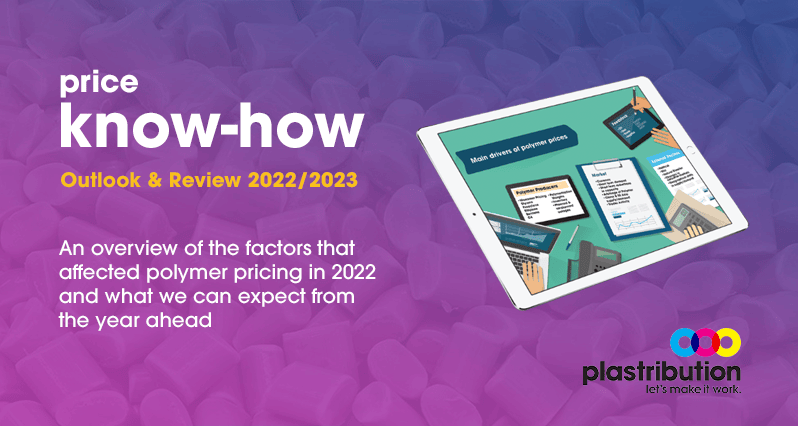
Price Know-How: Review of 2022 and Outlook for 2023
Leading polymer distributor, Plastribution, has released a detailed insight from Managing Director Mike Boswell on what we can expect for polymer pricing in 2023, alongside an overview of the factors that affected prices in the previous year.
2022 Review – Executive Overview

The market in 2022 was dominated by the Russian invasion of Ukraine, which was an event that came as a complete surprise to the whole world in February.
What for Russia, was expected to be a short conflict has subsequently become a long war in which the support for Ukraine from the West has resulted in retaliation from the Russians in the form of energy sanctions. Whether inflation was already becoming an issue in developed economies or not, the spiralling energy costs resulting from the Russian energy supply restrictions have caused significant inflation, with rates typically in and around 10%. Central banks in the US, Europe and the UK then applied significant hikes in base interest rates in an attempt to curb inflation.
Here in the UK, the Bank of England rate has already jumped up 3.4% with more likely to come; albeit, the impact of these changes on a generation of consumers who have never experienced more normal borrowing rates is unproven.
In the crude oil and petrochemicals sector, the risk of a global recession far outweighed any initial concerns about the scarcity of oil and gas supply from Russia. Prices fell dramatically from the record highs recorded just before the middle of the year, with the ‘polyolefin’s basket’ price falling some 25% by the end of December.
Energy costs became a key topic both for polymer producers and polymer converters, with each sector defined as energy intensive. For polymer converters in the UK, it was commonplace to hear of electricity price increases of up to 400% whenever fixed price deals were up for renewal, however, some of this extreme cost inflation has been offset by falling raw material costs and the possibility of some temporary government support. Polymer producers made some valiant efforts to pass through their energy cost increases, often in the form of surcharges, but these became unhinged by the challenging market dynamics.
Whilst the burgeoning supply of PP and PE from Russia was quickly aborted following the Russian invasion of Ukraine, the combination of diminished demand and revived PE supply from the USA, following constrained supply from that region in 2021, ensured that supply was plentiful. Furthermore, falling East-West shipping costs in H2 enabled the normal movement of plastics to resume on the basis that it is once again economically viable.
Despite the challenges of 2022, the UK plastics sector has once again demonstrated resilience in the face of significant challenges. Click here to read the in-depth analysis of what affected polymer prices in 2022, including Brexit, logistics, exchange rates, and information on specific materials.
2023 Outlook
UK Economic Outlook
Even before any mention of recession, most economists were already predicting that the UK would have the lowest rate of growth in the G7 due to the negative impacts of Brexit on trade. A global economic slowdown and rampant inflation will put further pressure on the UK economy, and higher interest rates will have a significant impact on the housing sector in which transaction volumes are expected to fall, but the prospect of falling average house prices will also significantly dent consumer confidence.
Whilst a UK economic slowdown may be more likely to affect services including leisure and entertainment, businesses will face significant cost pressures from factors including fixed and variable cost inflation, higher finance costs and an increase in the rate of corporation tax from 19% to 25%.
The UK Government continues to review the UK REACh legislation and has extended the deadlines for the full registration and announced that it will enter into discussion with regards to the need to closely follow EU REACh, or to take a different approach.
Global Geopolitical Issues
A rapid resolution of the Russian intention to invade Ukraine looks to be highly unlikely, and with this comes the prospect of increased tensions between East and West, although China appears to be resisting calls from President Putin to become more involved in the conflict.
The protracted withdrawal of Russian-origin crude oil, natural gas, refined products and petrochemical derivatives has resulted in a jump in prices for many of these essential commodities, and substitution with products from alternative origins will continue to require significant investment in infrastructure and resources, which in turn will have long-term consequences for price levels which are now likely to remain elevated into the long-term.
Logistics
The extreme spike in international shipping costs in 2022 is unlikely to recur in the foreseeable future, and as such the movement of polymers around the globe will not be subject to any prohibitive premiums. There remains the possibility that container shortages could recur if Covid-19 results in significant issues for the Chinese economy, or if the economic slowdown in the West results in slower turnarounds of shipping containers. Since the crisis last year, more shipping capacity is now on-stream and additional containers introduced.
On the domestic front, the issue with a shortage of HGV drivers appears to have eased, and even in the final quarter of 2022 when seasonal demand is high, there were no significant issues.
Further logistics cost inflation will take place in 2023, as providers look to recover cost increases and improve profitability. Inevitably these costs will be passed through the entire supply chain, and in part are an important factor in retail inflation.
Exchange Rates
Relative prospects for the UK economy are likely to dominate exchange rates throughout 2023. Whilst USD:GBP exchange rates are a typical reference, the perceived weakening of the US economy means that referencing against more stable currencies such as the Euro and JPY is likely to give a more accurate reflection of the views of the international markets on the value of the GBP.
With more stable domestic politics, there should be less volatility with exchange rates and it is expected that the GBP:Euro will continue to trade at similar levels throughout 2023.
Crude Oil
The likely scenario is that Brent Crude will continue to trade in the 70 – 90 USD per barrel range, with energy companies trying hard to manage supply in an economic environment that will tend towards falling prices, in an effort to stabilise the slowdown that is taking place.
It is notable that many traditional energy companies that have been heavily reliant on crude oil sales have increasingly diversified their sources of revenue, with many now turning more to renewables for sustainability both for the planet and for their business models.
Many energy companies also benefit from significant natural gas revenues, and until recently this has been a major source of profitability as prices have spiked on the back of supply restrictions from Russia.
Click here to read more detail about particular feedstocks and their outlook for the coming year.
Subscribe and keep in the know
Price Know-How is an industry-leading report to keep you updated on polymer pricing and market fluctuations. A trusted, go-to resource for over a decade, Price Know-how is produced by the thermoplastics experts at the leading polymer distributor, Plastribution, with data from Plastics Information Europe.
Unlike many pricing reports, Price Know-How is tailored specifically for the UK polymer industry. We do all the currency conversions, so you don’t need to!
Please click here to subscribe for free and receive monthly updates directly to your inbox.
Plastribution
+44 (0) 1530 560560
Website
Email






